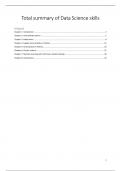Samenvatting
Summary of all Datacamp modules for Data Science Skills with import codes and steps to perform analysis (325243-M-6))
- Instelling
- Tilburg University (UVT)
This document contains a summary of all datacamp modules with all important codes, functions, methods and steps to perform certain analysis. Useful for pacticing before the exam.
[Meer zien]




